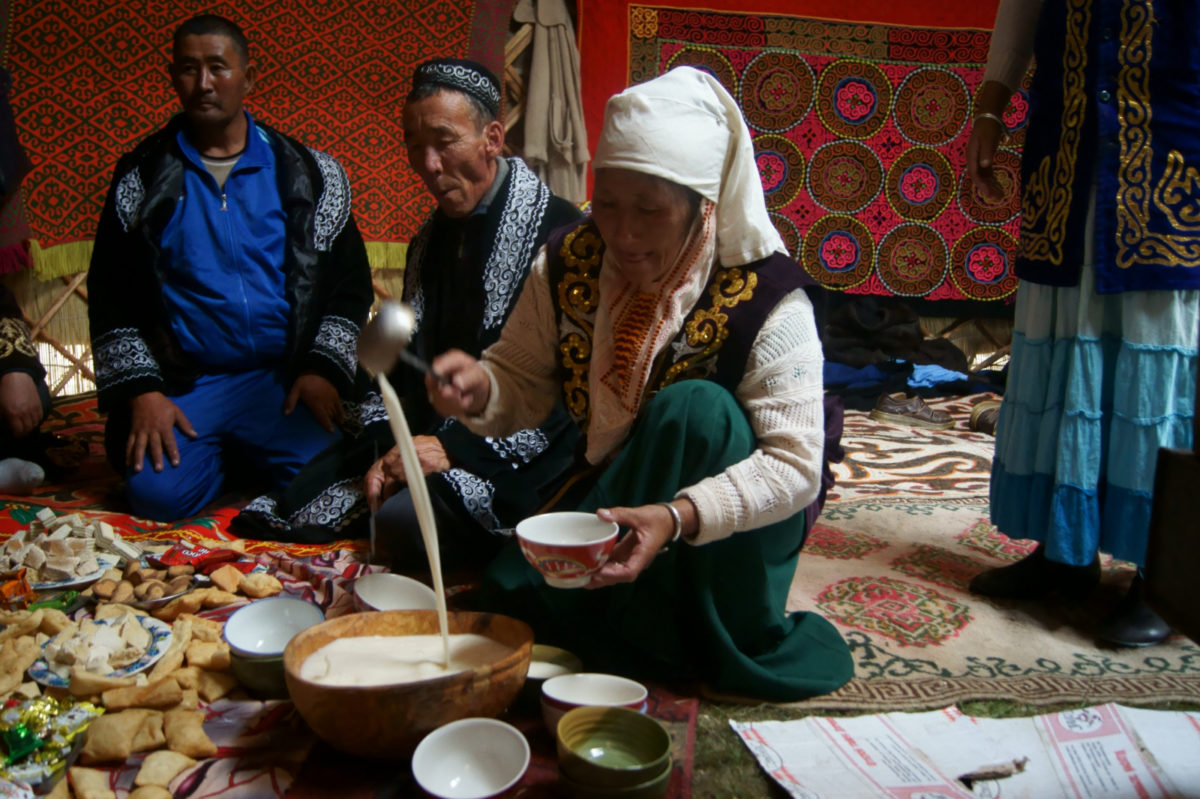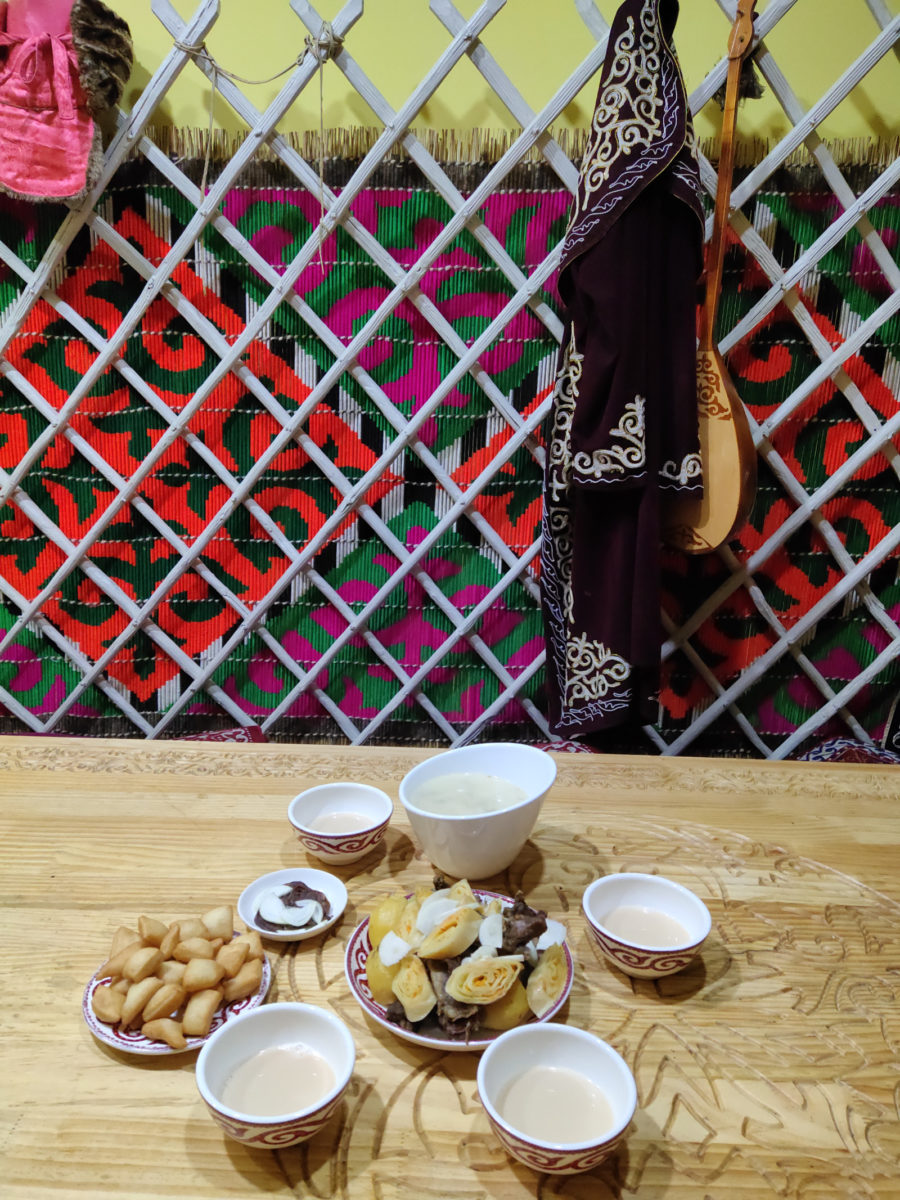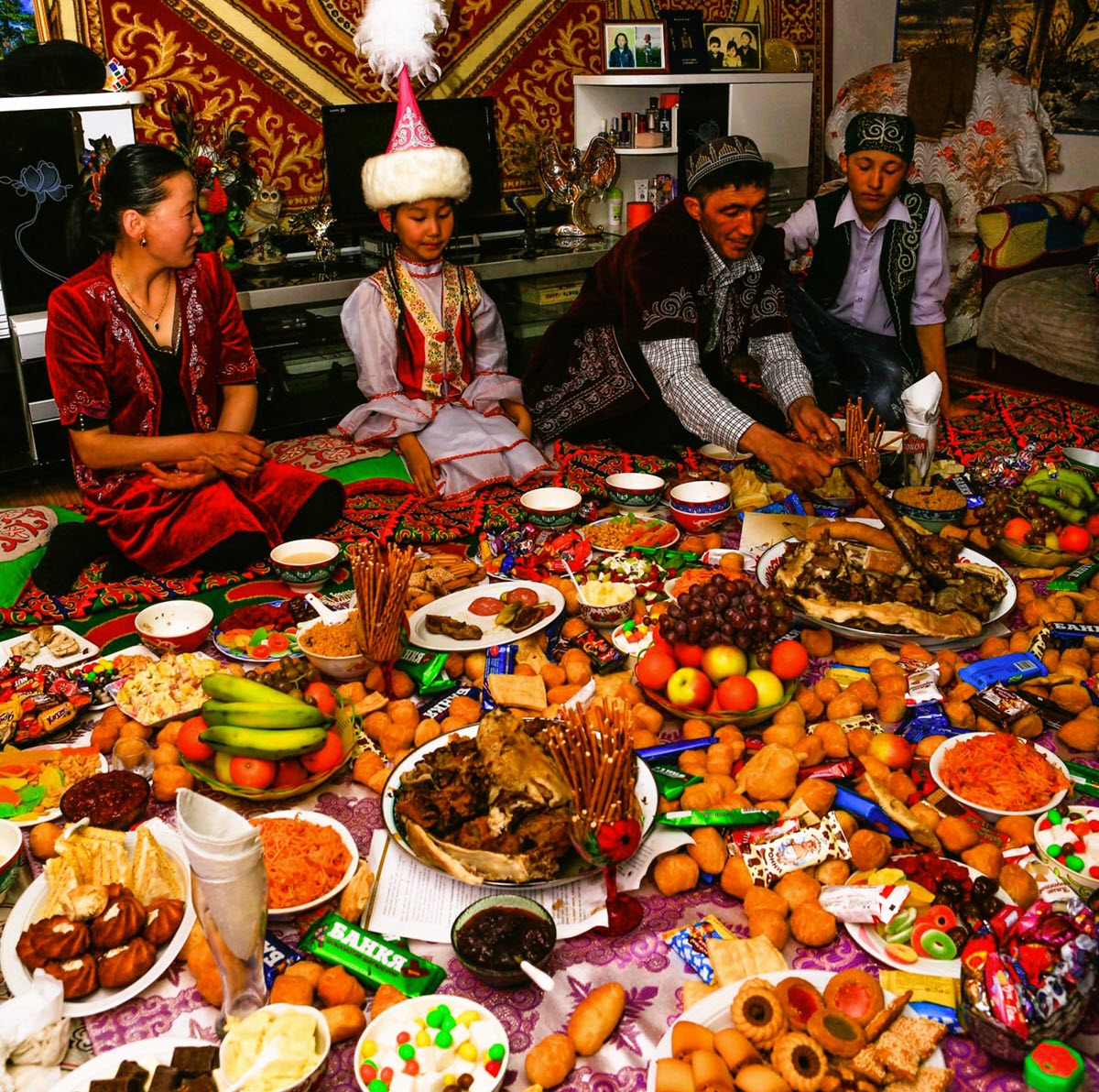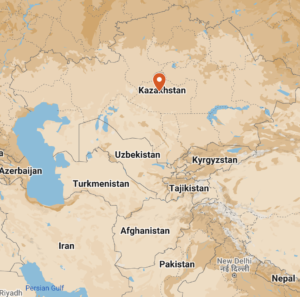
Tea plays an essential role in Kazakh culture, as no celebration or family feast is held without drinking tea. Sharing tea is a ritual of unity. When someone visits a Kazakh family, tea is served first. The custom, called syi-ayak, begins with the washing of hands. A bowl of black tea is served with or without lemon or milk and sometimes with fennel or cardamom. The tea is ladled or poured into a ceramic drinking bowl called a Piyala (Piala). The head of the family (husband) is the first to be served; the guests thereafter. Tradition holds that after dinner, everyone remains seated until the last person has finished drinking their tea, then everyone leaves together.

When tea is poured into a Piyala, filling a bowl to the brim is considered impolite. A half-filled bowl is a sign of respect for guests. The smaller portion is an invitation to keep the conversation going. If the bowl is filled to the brim, it signals the host wants the guest to drink up and depart soon. Tea is constantly ladled into the Piyala, so the drink remains hot. When the guest feels full or wishes to stop, they set down the bowl and cover it with five fingers to express their gratitude. Until they do, the tea keeps flowing.
Eraly Tugzhanov, former chairman of the Assembly of the People of Kazakhstan, writes that “tea always had a special significance in the steppe civilization because we know there is huge diplomacy behind it. We invited negotiations in the steppe to signify our design for harmony and peace. Tea invites us all to one table. It is one of the attributes of hospitality, unity, and identity of the people.”
Kazakhstan is a vast, mountainous, mineral-rich land, the ninth largest country in territory covering one million square miles. The country has vast steppes in the shadow of Khan Tengri, which rises 7,010 meters (22,900 feet). Kazakhstan borders China on the east and Russia. Kazakh tea culture resembles a Mongolian nomadic style, influenced by centuries of trade with China with a strong Russian influence. The country is one of the world’s top tea-consuming nations, averaging 1.54 kilos per capita. The population of 19 million typically drinks tea with every meal and between. Ninety-nine percent of Kazaks drink tea, and 50% drink four or more cups daily. According to market researchers, up to 3.5 billion liters of tea are consumed annually.

Early tea traditions differ depending on the region, which varies by geography and climate. A family feast includes fried baursak bread, dried fruit, and nuts.
Nomadic Kazakh people still drink thick milk tea in the countryside. Milk tea, known as shirchay, is flavored with salt and melted butter, sometimes thickened with flour, bits of mean, and fat. Adding fennel and cardamom to the blend creates Kazakh chai. In urban areas, black tea is far and away the most popular variety, often with milk and sugar. The juice of Uzbek lemon, which is the color orange, is commonly mixed with tea. Tashkent is a sweetened mix of green and black tea. Kazakhs call black tea қызыл шай, which means red tea in the local language. The word “red” indicates the color of the tea liquor, which should retain its red hue after adding milk. Brew times are long, and teas are robust.

The retail beverage market (including food service) is valued at $250 million. Revenue from eCommerce beverage transactions (hot and cold drinks) is estimated at $42.7 million in 2022, growing by almost 18% through 2025, according to Statista market research. Kazakhs drink about 60 million kilos of tea annually. Kazakhstan imported 29,251 metric tons of tea in 2020. The country’s tea growers processed 18,700 metric tons, of which 12,300 metric tons are consumed locally. In 2021 Kazakhstan ranked 35th among the world’s tea exporters, generating $19 million in sales, according to UN Comtrade.
Imports, valued at $82 million, were down by 19.1% in 2021. During the first quarter of 2021, the country imported 7,800 tons of bulk black teas (and some flavored tea), valued at $28 million, according to the National Statistical Committee.
Kenya supplied 46% of the total, followed by India (35%), Russia (9%), Vietnam (3%), and China (3%). Imports still outweigh the nation’s own production, representing 70% of the country’s demand for tea. Some 90% of tea imports are black tea, packaged in teabags and sold in 3kg boxes. During that same period, the Kazakh republic exported 2,500 metric tons of tea. Top export destinations were Russia, Kyrgyzstan, Uzbekistan, and Mongolia.
Consumer research by the Kazakhstan-based “Good Agency” in Almaty, the country’s largest city, found that black tea leads the market with 84% share, followed by fruit/herbal black tea blends (13%), green tea (2%), and fruit/herbal green blends (1%). Non-bagged tea dominates the market with a share of 70%. The top seven brands account for over 65% of the total market. In terms of brand, Piala (originated from Kenya) stands first with a 30% share, followed by Assam (16%), Greenfield (8%), Beta (6%), Simba (3%), and Lipton (2%).
Success story
More than ten tea factories operate in Kazakhstan, with blenders importing most of the bulk tea. Almaty, located in the foothills of the Trans-Ili Alatau mountains, is the major tea-producing region, accounting for 83% of the country’s total tea production. Key brands in the domestic market are Tea Center, RG Brands, and Orimi. Tea Center holds a 20% market share.
When the owners of Tea Center contacted the European Bank of Reconstruction & Development (EBRD) in 2017, they had a fast-growing but relatively unstructured tea production business. The family-run firm previously operated in a cluttered warehouse with no certain development plan. Thanks to an international advisory project with the EBRD funded by the Kazakh government, Tea Ceterr has developed a detailed strategy, a new budgeting system, and a leaner production facility for their rebranded products. As a result, sales rose by 35%, and profit grew by over 50%.
The company imports processed leaves from Kenya, India, Sri Lanka, and China, producing over 2,500 tons of tea annually with plans to continue expanding.
Teapots are not afraid of coffee pots
Although out-of-home consumption at coffee chains and family coffee consumption in-home are gradually rising, hotels, resorts, and catering are expanding quicker. Entrepreneurs in the tea business do not see a threat from coffee competitors. The soft drinks market is dynamic, and the popularity of a particular product is undulating.
Mezrab-Nasib Khalilov, manager of the capital’s oriental restaurant “Alasha,” explains that about ten years ago, the interest in tea in the restaurant was lower because the market was flooded with soda and natural juices. But during the past three years, the demand for tea in restaurants has grown by almost a quarter.
Market trends
The tea market is mature and quite saturated. Therefore, its development is going in the following directions: bagged and leaf tea for sub-premium and premium segments, as well as fruit-herbal blends of green and black tea.
Tea companies with offerings targeting the middle and lower segments have reoriented to higher ones. Against this background, brands in the “standard” segment and below showed a drop.
The trend of naturalness will continue to influence the tea market. At the same time, stagnation is possible in the total volume due to slowing economic growth. He said that would will continue to adjust, anticipating growing demand for better quality granulated (CTC) and fruity-herbal blends. He predicts the share of tea bags will grow, both the most convenient solution and the format in which fruit and herbal tea are mainly packaged.
Although it is difficult to call such a trend premiumization, it is clear that consumers want not just to “drink tea” but to enjoy the taste and aroma, knowing about its origin. Also, Euromonitor research shows herbal and flavored teas are a growing market segment. The research company states domestic producers like Tea Center are starting to offer low-priced flavored varieties.
The Kazakh market for cold tea shows high growth rates. During the COVID-19 quarantine, the bottled iced tea market continued to rise. This market is forecast to grow by 4%-7% in the next three years.